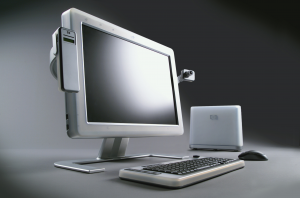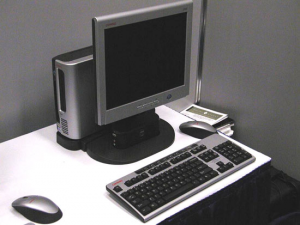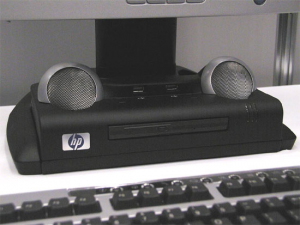Athens PC: Difference between revisions
No edit summary |
m (Minor textual corrections. Removed stub category, added a new gallery section (yes, there will be more images soon).) |
||
| Line 1: | Line 1: | ||
[[File:Athens.png|right|thumb|The "Athens" PC.]] | [[File:Athens.png|right|thumb|The "Athens" PC.]] | ||
The '''"Athens" PC''' was a prototype personal computer developed between 2002 and 2004 by [http://en.wikipedia.org/wiki/Hewlett-Packard Hewlett-Packard] in collaboration with the [[Microsoft]] | The '''"Athens" PC''' was a prototype personal computer developed between 2002 and 2004 by [http://en.wikipedia.org/wiki/Hewlett-Packard Hewlett-Packard] in collaboration with the [[Microsoft|Microsoft Corporation]]. | ||
==History== | ==History== | ||
| Line 9: | Line 9: | ||
==="Athens" PC=== | ==="Athens" PC=== | ||
In 2003, "Agora" was succeeded by a new prototype PC called the "Athens". This new PC was based on the previous "Agora" design and included several new hardware features, including an uninterruptible power supply, and LED lights on the top of the display monitor to alert the user of events such as a new voicemail or e-mail message | In 2003, "Agora" was succeeded by a new prototype PC called the "Athens". This new PC was based on the previous "Agora" design and included several new hardware features, including an uninterruptible power supply, and LED lights on the top of the display monitor to alert the user of events such as a new voicemail or e-mail message or an upcoming appointment. Microsoft publicly demonstrated the "Athens" PC for the first time during its [[Windows Hardware Engineering Conference 2003|Windows Hardware Engineering Conference of 2003]] (WinHEC 2003).<ref>Microsoft PressPass. (May 6, 2003). [http://www.microsoft.com/en-us/news/press/2003/may03/05-06winhec2003keynotepr.aspx "Bill Gates Unveils Next Wave of Windows PC Innovation at WinHEC 2003"]</ref><ref>Thurrott, Paul. (May 5, 2003). [http://windowsitpro.com/windows-server/winhec-2003-microsoft-hp-unveil-athens-pc "WinHEC 2003: Microsoft, HP Unveil Athens PC"]</ref><ref>Dudley, Brier. (May 6, 2003). [http://community.seattletimes.nwsource.com/archive/?date=20030506&slug=winhec06 The Seattle Times - "Microsoft 'Athens' built on strategy for new PC golden age"]</ref> After WinHEC 2003, there were claims that the company was deliberately imitating its competitor [[Apple]] in the areas of hardware design and software features.<ref>Seward, Vern. (May 11, 2003). [http://www.macobserver.com/tmo/article/NY_Times_Quotes_Apple_Exec_On_Microsofts_Athens_PC_Prototype "NY Times Quotes Apple Exec On Microsoft’s Athens PC Prototype"]</ref> Speaking of the then new [[Desktop Window Manager|desktop compositor]] in Microsoft's [[Windows:Longhorn|Windows "Longhorn"]] operating system, Phillip Schiller, then vice president of Apple marketing, stated that the technology in "Longhorn" was "almost a direct copy of ''Quartz''" in reference to Apple's own composition technology.<ref>Markoff, John. (May 12, 2003). [http://www.nytimes.com/2003/05/12/technology/12SOFT.html "Apple Tweaks Microsoft Over a New Computer"]</ref> | ||
The "Athens" PC would later be displayed in presentations at Microsoft's [[Professional Developers Conference 2003|Professional Developers Conference of 2003]] during Hillel Cooperman's keynote titled "The New Windows 'Longhorn' User Experience: Get Users to Fall in Love with Your Software".<ref>Zheng, Long. (April 14, 2007). [http://www.istartedsomething.com/20070414/getting-users-fall-love-software-pdc03-videos/ “'Getting Users to Fall in Love with Your Software' videos from PDC 2003"]</ref> | The "Athens" PC would later be displayed in presentations at Microsoft's [[Professional Developers Conference 2003|Professional Developers Conference of 2003]] during Hillel Cooperman's keynote titled "The New Windows 'Longhorn' User Experience: Get Users to Fall in Love with Your Software".<ref>Zheng, Long. (April 14, 2007). [http://www.istartedsomething.com/20070414/getting-users-fall-love-software-pdc03-videos/ “'Getting Users to Fall in Love with Your Software' videos from PDC 2003"]</ref> | ||
New PC designs based on "Athens" were unveiled during [[Windows Hardware Engineering Conference 2004|WinHEC 2004]].<ref>Microsoft PressPass. (May 3, 2004). [http://www.microsoft.com/en-us/news/features/2004/may04/05-03winhec.aspx "Q&A: 'Athens' Prototype PC Inspires Innovations Showcased at WinHEC 2004"]</ref> A new prototype mobile PC, called [["Hermes" PC|"Hermes"]], featured a wireless display unit designed for activities such as presentations, and an integrated web camera. A prototype business PC, called [["Troy" PC|"Troy"]] included an integrated dock for a PDA allowing it to be used as a secondary display. "Troy" also made changes to | New PC designs based on "Athens" were unveiled during [[Windows Hardware Engineering Conference 2004|WinHEC 2004]].<ref>Microsoft PressPass. (May 3, 2004). [http://www.microsoft.com/en-us/news/features/2004/may04/05-03winhec.aspx "Q&A: 'Athens' Prototype PC Inspires Innovations Showcased at WinHEC 2004"]</ref> A new prototype mobile PC, called [["Hermes" PC|"Hermes"]], featured a wireless display unit designed for activities such as presentations, and an integrated web camera. A prototype business PC, called [["Troy" PC|"Troy"]], included an integrated dock for a PDA allowing it to be used as a secondary display. "Troy" also made changes to accommodate feedback received after the "Athens" was unveiled, such as relocating various hardware controls previously featured on the "Athens" keyboard into the base of the main display monitor. According to HP's Brian Schmitz, the "Troy" PC would be the last major PC prototype unveiled before the company would release an actual product.<ref>Hachman, Mark. (May 4, 2004). [http://www.extremetech.com/extreme/56292-microsoft-hp-unveil-new-pc-designs "Microsoft, HP Unveil New PC Designs"]</ref> | ||
In 2005, Microsoft stated that it had made progress toward the vision demonstrated by "Athens" with the new features included in its [[Windows:Vista|Windows Vista]] (then codenamed "Longhorn") operating system, including support for microphone array processing technology, new audio features and glitch-free playback powered by a new audio subsystem, and improvements to the native Windows Bluetooth subsystem. Microsoft also stated that many aspects of its "Athens" vision were realized in the new features included with its ''Office Communicator 2005'' and ''Office Live Communications Server 2005'' products.<ref>Microsoft PressPass. (April 25, 2005). [http://www.microsoft.com/en-us/news/features/2005/apr05/04-25conceptpc.aspx "Concept PCs Continue to Shape the Future of Computing"]</ref> Elements of the "Athens" PC would later reemerge in prototype personal computers developed by the ''Carbon Design Group'' for Microsoft's Windows Vista operating system.<ref>Carbon Design Group. [http://www.carbondesign.com/wp-content/uploads/2010/06/CarbonDesignConsumerCaseStudies.pdf "Consumer Product Case Studies"]</ref><ref>Zheng, Long. (September 17, 2007). [http://www.istartedsomething.com/20070917/revisiting-microsofts-vista-pc-concept/ "Revisiting Microsoft's 'Vista PC' concept"]</ref> | In 2005, Microsoft stated that it had made progress toward the vision demonstrated by "Athens" with the new features included in its [[Windows:Vista|Windows Vista]] (then codenamed "Longhorn") operating system, including support for microphone array processing technology, new audio features and glitch-free playback powered by a new audio subsystem, and improvements to the native Windows Bluetooth subsystem. Microsoft also stated that many aspects of its "Athens" vision were realized in the new features included with its ''Office Communicator 2005'' and ''Office Live Communications Server 2005'' products.<ref>Microsoft PressPass. (April 25, 2005). [http://www.microsoft.com/en-us/news/features/2005/apr05/04-25conceptpc.aspx "Concept PCs Continue to Shape the Future of Computing"]</ref> Elements of the "Athens" PC would later reemerge in prototype personal computers developed by the ''Carbon Design Group'' for Microsoft's Windows Vista operating system.<ref>Carbon Design Group. [http://www.carbondesign.com/wp-content/uploads/2010/06/CarbonDesignConsumerCaseStudies.pdf "Consumer Product Case Studies"]</ref><ref>Zheng, Long. (September 17, 2007). [http://www.istartedsomething.com/20070917/revisiting-microsofts-vista-pc-concept/ "Revisiting Microsoft's 'Vista PC' concept"]</ref> | ||
Although the "Athens" and subsequent PC prototypes were not released, Microsoft employee M3 Sweatt wrote in 2012 that most of the hardware predictions he made when | Although the "Athens" and subsequent PC prototypes were not released, Microsoft employee M3 Sweatt wrote in 2012 that most of the hardware predictions he made when "Athens" was in development had come to pass as technology advanced.<ref>Sweatt, M3. (January 3, 2012). [http://blogs.msdn.com/b/mthree/archive/2012/01/03/futurepc-010312.aspx "A past look at future tech: thoughts on the Windows PC of 2008 back in 2003... and 2012's in 2008"]</ref> | ||
==Gallery== | |||
==References== | ==References== | ||
| Line 27: | Line 29: | ||
* [http://www.electronicsforu.com/EFYLinux/efyhome/cover/july2003/Athens.pdf ''Electronics For U'' - "Athens" informational document] | * [http://www.electronicsforu.com/EFYLinux/efyhome/cover/july2003/Athens.pdf ''Electronics For U'' - "Athens" informational document] | ||
[[Category:Cancelled Projects]] | [[Category:Cancelled Projects]] | ||
[[Category:Windows "Longhorn"]] | [[Category:Windows "Longhorn"]] | ||
Revision as of 04:33, 10 August 2014
The "Athens" PC was a prototype personal computer developed between 2002 and 2004 by Hewlett-Packard in collaboration with the Microsoft Corporation.
History
"Agora" PC
Development of the "Athens" PC began as a collaborative effort between Hewlett-Packard and Microsoft known as the "Agora" PC. The "Agora" PC was designed to be a real time communications device for business, and was demonstrated by HP at the COMDEX computer exposition in 2002 as an extension of the company's e-PC series of small form factor computers.[1] "Agora" included a flat-panel LCD display monitor which housed expansion ports, speakers, and an optical disc drive at the base of the unit; wireless peripheral devices powered by Bluetooth technology, and integrated telecommunication hardware. To demonstrate the capabilities of the machine, a conceptual video was displayed during COMDEX which showed a user of the "Agora" PC using Windows Messenger to conduct a video conference with a prototype device which used several cameras to display a 360-degree panorama; the video also showed the user collaborating on documents with other "Agora" users in real time.[1] While previous PCs had already included much of the functionality of "Agora" through the use of supplementary hardware and software, "Agora" was designed to bring all of the functionality together without requiring additional products or services.
"Athens" PC
In 2003, "Agora" was succeeded by a new prototype PC called the "Athens". This new PC was based on the previous "Agora" design and included several new hardware features, including an uninterruptible power supply, and LED lights on the top of the display monitor to alert the user of events such as a new voicemail or e-mail message or an upcoming appointment. Microsoft publicly demonstrated the "Athens" PC for the first time during its Windows Hardware Engineering Conference of 2003 (WinHEC 2003).[2][3][4] After WinHEC 2003, there were claims that the company was deliberately imitating its competitor Apple in the areas of hardware design and software features.[5] Speaking of the then new desktop compositor in Microsoft's Windows "Longhorn" operating system, Phillip Schiller, then vice president of Apple marketing, stated that the technology in "Longhorn" was "almost a direct copy of Quartz" in reference to Apple's own composition technology.[6]
The "Athens" PC would later be displayed in presentations at Microsoft's Professional Developers Conference of 2003 during Hillel Cooperman's keynote titled "The New Windows 'Longhorn' User Experience: Get Users to Fall in Love with Your Software".[7]
New PC designs based on "Athens" were unveiled during WinHEC 2004.[8] A new prototype mobile PC, called "Hermes", featured a wireless display unit designed for activities such as presentations, and an integrated web camera. A prototype business PC, called "Troy", included an integrated dock for a PDA allowing it to be used as a secondary display. "Troy" also made changes to accommodate feedback received after the "Athens" was unveiled, such as relocating various hardware controls previously featured on the "Athens" keyboard into the base of the main display monitor. According to HP's Brian Schmitz, the "Troy" PC would be the last major PC prototype unveiled before the company would release an actual product.[9]
In 2005, Microsoft stated that it had made progress toward the vision demonstrated by "Athens" with the new features included in its Windows Vista (then codenamed "Longhorn") operating system, including support for microphone array processing technology, new audio features and glitch-free playback powered by a new audio subsystem, and improvements to the native Windows Bluetooth subsystem. Microsoft also stated that many aspects of its "Athens" vision were realized in the new features included with its Office Communicator 2005 and Office Live Communications Server 2005 products.[10] Elements of the "Athens" PC would later reemerge in prototype personal computers developed by the Carbon Design Group for Microsoft's Windows Vista operating system.[11][12]
Although the "Athens" and subsequent PC prototypes were not released, Microsoft employee M3 Sweatt wrote in 2012 that most of the hardware predictions he made when "Athens" was in development had come to pass as technology advanced.[13]
Gallery
References
- ↑ 1.0 1.1 Hachman, Mark. (November 20, 2002). "HP, Microsoft Crafting 'Communications PC'"
- ↑ Microsoft PressPass. (May 6, 2003). "Bill Gates Unveils Next Wave of Windows PC Innovation at WinHEC 2003"
- ↑ Thurrott, Paul. (May 5, 2003). "WinHEC 2003: Microsoft, HP Unveil Athens PC"
- ↑ Dudley, Brier. (May 6, 2003). The Seattle Times - "Microsoft 'Athens' built on strategy for new PC golden age"
- ↑ Seward, Vern. (May 11, 2003). "NY Times Quotes Apple Exec On Microsoft’s Athens PC Prototype"
- ↑ Markoff, John. (May 12, 2003). "Apple Tweaks Microsoft Over a New Computer"
- ↑ Zheng, Long. (April 14, 2007). “'Getting Users to Fall in Love with Your Software' videos from PDC 2003"
- ↑ Microsoft PressPass. (May 3, 2004). "Q&A: 'Athens' Prototype PC Inspires Innovations Showcased at WinHEC 2004"
- ↑ Hachman, Mark. (May 4, 2004). "Microsoft, HP Unveil New PC Designs"
- ↑ Microsoft PressPass. (April 25, 2005). "Concept PCs Continue to Shape the Future of Computing"
- ↑ Carbon Design Group. "Consumer Product Case Studies"
- ↑ Zheng, Long. (September 17, 2007). "Revisiting Microsoft's 'Vista PC' concept"
- ↑ Sweatt, M3. (January 3, 2012). "A past look at future tech: thoughts on the Windows PC of 2008 back in 2003... and 2012's in 2008"


